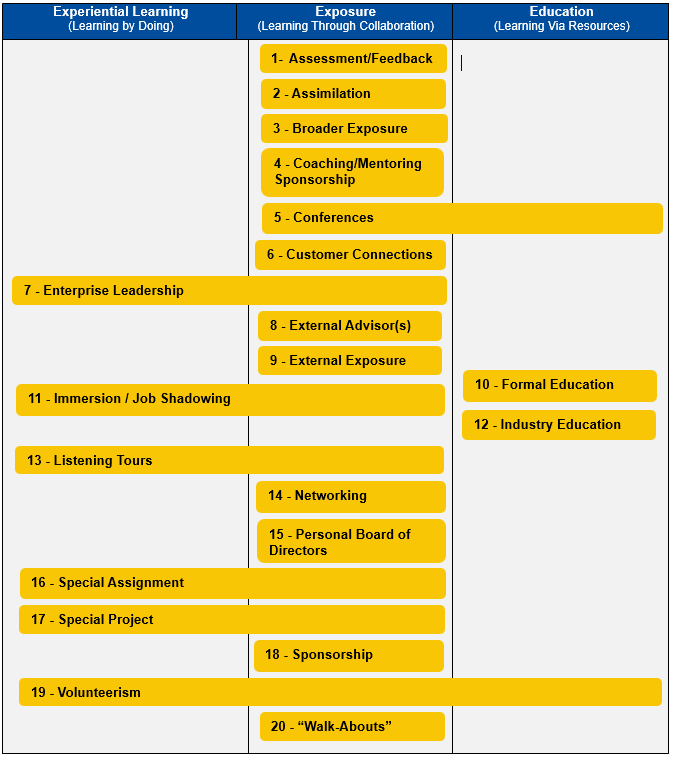KEY
|
|
1
|
Assimilation
|
-
Ensure alignment of expectations with me and my team.
-
Often conducted in partnership with an HR Business Partner.
|
|
2
|
Assessment & Feedback
|
-
Formal 360-feedback assessment to gain insights into personal leadership strengths and opportunities; often conducted in partnership with an HR Business Partner in which an action plan is developed and executed.
-
Participation in other company-sponsored feedback tools (e.g., Hogan, DiSC, MBTI).
-
Assessments are often conducted with external coaching engagements.
|
|
3
|
Broader Exposure
|
-
Role/visibility at key enterprise events (e.g., town halls, all employee meetings, forums).
-
Engagement with company CEO, senior leaders, and/or Board of Directors.
|
|
4
|
Coaching and Mentoring
|
-
Coaching from my leader, peers, and other stakeholders.
-
External coaching engagement (conducted in partnership with an HR Business Partner).
|
|
5
|
Conferences
|
-
Attend external industry or other related conferences to build capabilities, gain insights into trends and best practices, and network.
|
|
6
|
Customer Expectations
|
-
Formal meetings (in person or virtual) to gain views into customer experiences and needs related to products, service, technology, and key partnerships.
|
|
7
|
Enterprise Leadership
|
Provide leadership for an enterprise group, initiative, or program. Examples include:
-
Employee Resource Group sponsor
-
Well-Being or Career Development Champion
-
Company 90-day challenge sponsor
-
High Potential Leader program spokesperson
|
|
8
|
External Advisor/s
|
Development partnership with a senior or retired leader “who has been there” (depending upon development needs, an advisor could be internal or external to the industry).
-
These relationships are helpful for executives leading large scale transformation efforts to gain insights into best practices, experiences, successes, and leadership lessons.
|
|
9
|
External Exposure
|
Give back to the industry by serving on:
-
External Boards of Directors or industry affiliations
-
Local initiatives within the company footprint (e.g., NYC Advisory Board Economic Development)
-
Industry committees, councils, or advisory roles (e.g., Workplace Benefits Advisory Board)
-
Local hometown Board of Director role (e.g., Lincoln Hospital Board)
|
|
10
|
Formal Education
|
Build knowledge and expertise
-
Degree programs (e.g., MBA)
-
Certificate and designation programs (e.g., FLMI); licenses
-
Executive development programming
|
|
11
|
Immersions or Job Shadowing
|
Leveraged by executives to understand roles, process, or pain points. Examples include:
-
Observing claims processing via multiple legacy systems and related customer impacts.
-
Shadowing call center employees during busy season when customer expectations are high.
-
Selling a product or service to a prospective customer.
-
Listen to customer calls related to service or product issues.
-
Shadowing various functional hand-offs related to a process that may not be working.
|
|
12
|
Industry/Other Education
|
-
Research, online publications, webinars, podcasts, LinkedIn; study groups
-
LIMRA and LOMA programming
-
Company-sponsored learning opportunities
|
|
13
|
Listening Tours
|
-
Leveraged by executives new to a company or business area to gain insights from employees, customers, or other stakeholders (e.g., what is going well; what could be better; or to understand the impacts of business processes, etc.).
-
Established leaders often conduct internal “skip or deeper level” meetings to gain
-
Exposure to specific employee populations related to engagement, retention, and customer experience.
|
|
14
|
Networking
|
Making connections and building relationships within the organization and key partners.
|
|
15
|
Personal Board of Directors
|
Group of 15-20 individuals or “trusted advisors” leveraged to gain insights to inform decision-making and/or to test ideas; examples include:
-
Cross-functional group of employees to consider customer impacts prior to product launch.
-
Team of mid-level leaders and HR partners to test re-skilling proposal due to AI initiatives.
-
CEO leveraging employees to validate learning regarding employee engagement.
|
|
16
|
Special Assignment
|
Assignments to build capabilities and experiences.
-
Rotational assignment (e.g., rotate through 3 functional job assignments in 24-months)
-
Expat assignment (e.g., global assignment)
-
Action learning assignment (e.g., “establishing self as a leader” within a new functional area; assessing the impacts of AI on customer experience)
|
|
17
|
Special Project
|
-
Engagement in a key initiative (e.g., enterprise, global, functional, or cross-functional).
|
|
18
|
Sponsorship
|
-
Personal sponsorship (“advocacy”) by a leader 1-2 level higher in the company (not my leader) who can share insights, leadership lessons and challenge thinking.
|
|
19
|
Volunteerism
|
-
Participation in company-sponsored days of service or local community volunteer work.
|
|
20
|
Walk-Abouts
(Live and Virtual)
|
“Purposeful” engagement with others. Examples include:
-
Prior to traveling to company locations, identify key talent to meet; hold “Coffee Chats.”
-
At company locations, walk through business areas; chat with employees; be visible.
-
Schedule virtual “surfing time” on a Friday to connect individually with 3-5 people to meet.
- Schedule “walk and talks” with others to gain views on various things.
|



